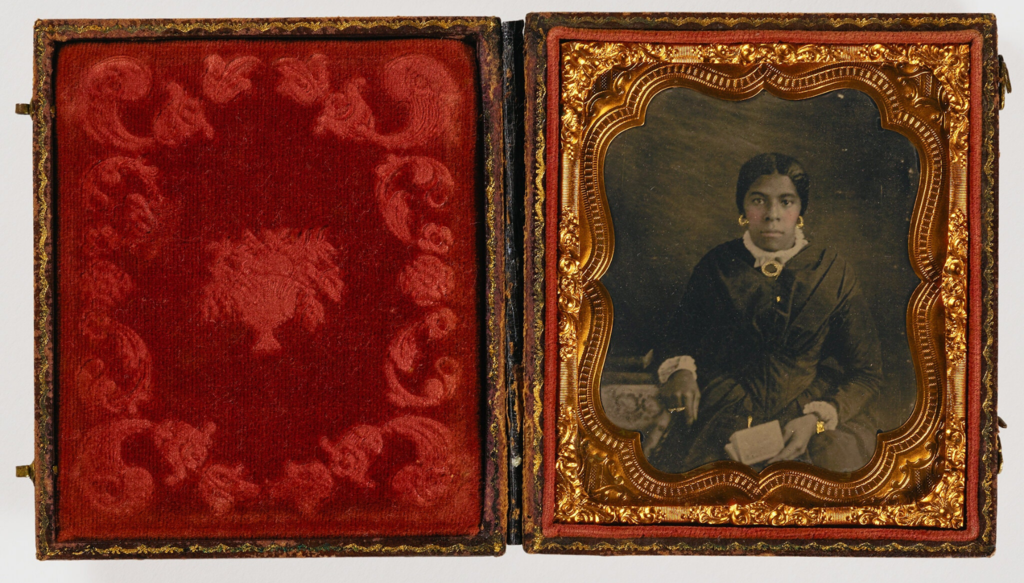He’s been collecting the photographs for over 40 years!
The Smithsonian recently acquired rare daguerreotype photographs from a local collector that portrays work from the first Black photography studios, The New York Times reports.
Larry West first began collecting in 1975, after coming across a New York Post article mentioning that antique photographs would become the next big collectibles. West randomly walked into a shop in Mamaroneck, NY, and came across a daguerreotype – an early form of photography made on polished metal plates. The photo depicted a Black man in a tuxedo, which West purchased for $10.70.

Photo Courtesy of the Smithsonian American Art Museum
Since then, he’s spent 45 years collecting daguerreotypes, not just for their beauty but also for their history. They highlight the roles Black people played as both makers and consumers of this early photographic innovation. Now, a pertinent portion of West’s collection has been acquired by the Smithsonian American Art Museum (SAAM) in Washington, D.C. Museum director Stephanie Stebich said the purchase price was in the mid-six figures.
The set of 286 objects dates back from the 1840s to the mid-1920s and includes 40 daguerreotypes made by three prominent Black photographers of the 19th century, James P. Ball, Glenalvin Goodridge, and Augustus Washington. The collection is the largest of this type of work in the country, surpassing the Library of Congress’ collection of 26 daguerreotypes. The collection also includes photographic jewelry, objects worn on the body embedded with tiny daguerreotypes, or other types of photos, some even with locks of hair. The collection, made by and for Black people, is considered “the rarest of the rare.” Portraits of abolitionists and photographs of key Underground Railroad figures – both Black and white – are also included.

Photo Courtesy of the Smithsonian American Art Museum
“[The collection] really allows us to dramatically expand the canvas that most people see when they think of early photography in the United States…What I’m so pleased about is not only the representation of women abolitionists, but also the representation of African American photographers who are often undervalued and overlooked,” Lonnie G. Bunch III, secretary of the Smithsonian, said.
SAAM is preparing to launch a reinstallation of many of its permanent collections. The addition of West’s collection is aligned and will play a central role in the curation. John Jacob, the SAAM’s curator for photography, said West’s collection helps tell a story that otherwise wouldn’t have been told. The daguerreotype process was a new and more affordable way for everyday people to capture themselves. Not only were Black photographers at the forefront of the process, Black people of means took advantage of it by the droves, allowing them to build entire studios.
“The transition from miniature painting to the photographic portrait is really a democratization of portraiture. But in order to explore that story, a collection has to have diverse photographers, and the images have to have diverse subjects – that’s the only way to tell the story of democratization. We couldn’t tell this story before; now, by bringing in Larry’s collection, this is something [we] can do now,” Jacob said.

Photo Courtesy of the Smithsonian American Art Museum
Ball, Goodridge, and Washington all established studios that excelled, serving black and white clientele across Cincinnati, Minneapolis, Montana, Pennsylvania, and Connecticut. Their work displayed in this new collection has the power to change what currently exists about the early history of photography in the nation. All three photographers were staunch abolitionists, and their work adds another layer to Black life during that period, spotlighting the beauty of Black people, not just their struggle.
“It tells us that everyday African Americans were both consumers and producers of this new media, that they recognized its importance right away. Not only did we create images for ourselves, but we were participating in the development of this new technology,” Makeda Best, curator of photography at the Harvard Art Museums, said.
West’s research materials and his recollection of the collection will be included in the acquisition, Stebich calling it “a treasure trove for whole new generations of art historians.”
The collector says the acquisition is a dream come true.
“All collectors and historians have this dream for their collections – is my material going to be used, and is it going to endure? [Now the Smithsonian] can tell a lot of stories they couldn’t tell before,” said West.
The collection is currently set to be available for public view in the fall of 2023.
Photo Courtesy of the Smithsonian American Art Museum

